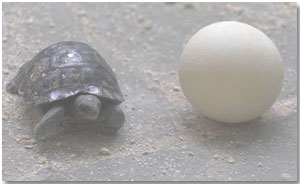|
Galapagos Giant Tortoise EggsIf you looked into a nest of galapagos giant tortoise eggs, you would see 2 to 16 eggs that look a lot like tennis balls. But if you touched them, you would find that they have hard shells.
The tortoises grow inside their eggs for 4 to 8 months. When the galapagos giant tortoise eggs hatch, the hatchlings begin to dig their way out of the nest. That can take a month. A full grown galapagos tortoise can weigh more than 225 kg or 500 pounds and be almost 2 m or 6 feet long. But the hatchlings weigh about 80 g or 2.8 ounces and are only 6 cm or 2.4 inches long. If you grew as much as a galapagos tortoise, you would weigh almost 8500 kg or about 9 tons as an adult! Most tortoises and turtles lay many more eggs than the galapagos tortoise does. Predators kill most of the eggs or hatchlings. Hundreds of years ago there were no predators for the galapagos tortoise. When people started visiting the Galapgos Islands, the people brought animals that like to eat the eggs and the hatchlings. Now people have to help the hatchlings to live long enough to grow up so they can have their own babies. That takes 40 years! From Galapagos Giant Tortoise Eggs to Tortoise Facts Keep it slow and steady. |



